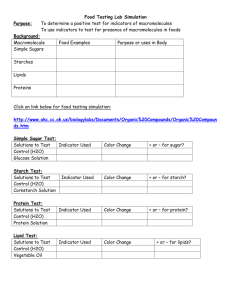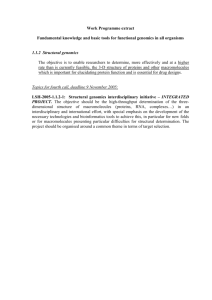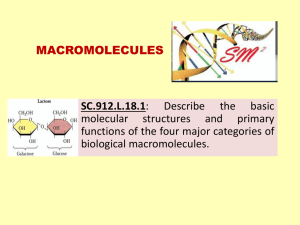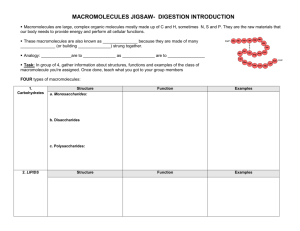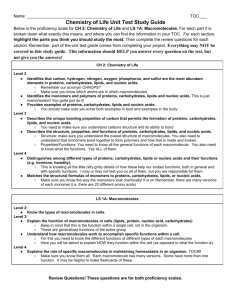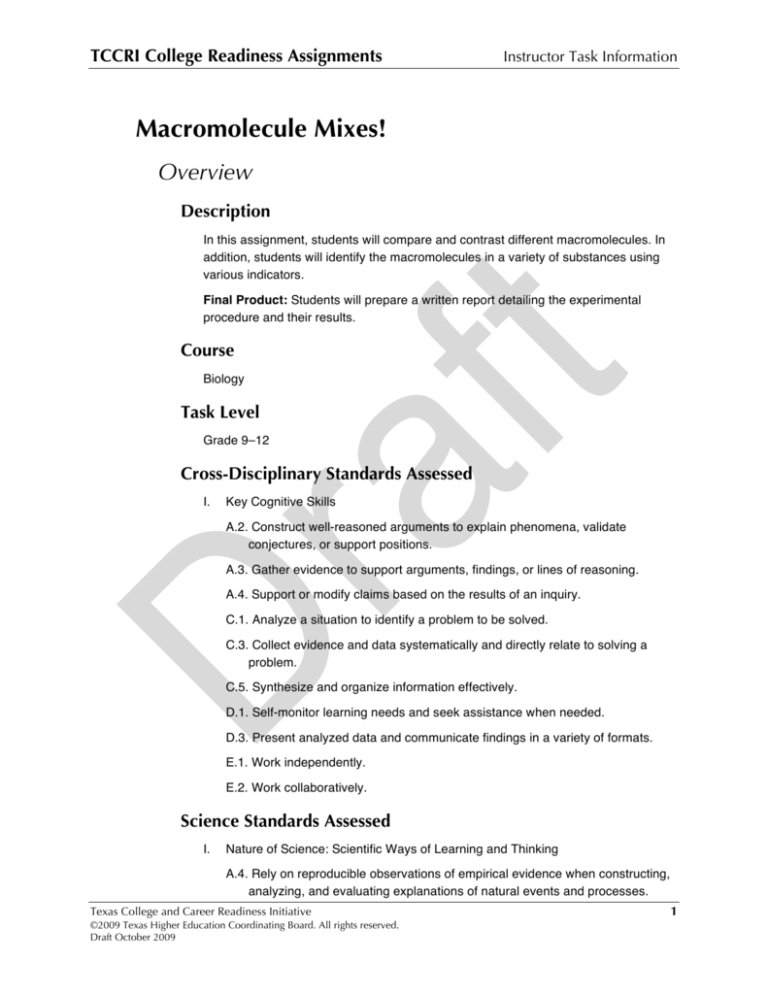
TCCRI College Readiness Assignments
Instructor Task Information
Macromolecule Mixes!
Overview
Description
In this assignment, students will compare and contrast different macromolecules. In
addition, students will identify the macromolecules in a variety of substances using
various indicators.
Final Product: Students will prepare a written report detailing the experimental
procedure and their results.
Course
Biology
Task Level
Grade 9–12
Cross-Disciplinary Standards Assessed
I.
Key Cognitive Skills
A.2. Construct well-reasoned arguments to explain phenomena, validate
conjectures, or support positions.
A.3. Gather evidence to support arguments, findings, or lines of reasoning.
A.4. Support or modify claims based on the results of an inquiry.
C.1. Analyze a situation to identify a problem to be solved.
C.3. Collect evidence and data systematically and directly relate to solving a
problem.
C.5. Synthesize and organize information effectively.
D.1. Self-monitor learning needs and seek assistance when needed.
D.3. Present analyzed data and communicate findings in a variety of formats.
E.1. Work independently.
E.2. Work collaboratively.
Science Standards Assessed
I.
Nature of Science: Scientific Ways of Learning and Thinking
A.4. Rely on reproducible observations of empirical evidence when constructing,
analyzing, and evaluating explanations of natural events and processes.
Texas College and Career Readiness Initiative
©2009 Texas Higher Education Coordinating Board. All rights reserved.
Draft October 2009
1
Macromolecule Mixes!
Instructor Task Information
B.1. Design and conduct scientific investigations in which hypotheses are
formulated and tested.
C.1. Collaborate on joint projects.
C.2. Understand and apply safe procedures in the laboratory and field, including
chemical, electrical, and fire safety and safe handling of live or preserved
organisms.
C.3. Demonstrate skill in the safe use of a wide variety of apparatuses,
equipment, techniques, and procedures.
D.3. Demonstrate appropriate use of a wide variety of apparatuses, equipment,
techniques, and procedures for collecting quantitative and qualitative data.
II. Foundation Skills: Scientific Applications of Communication
B.2. Set up apparatuses, carry out procedures, and collect specified data from a
given set of appropriate instructions.
C.1. Prepare and present scientific/technical information in appropriate formats
for various audiences.
IV. Biology
B.1. Understand the major categories of biological molecules: lipids,
carbohydrates, proteins, and nucleic acids.
Objectives
Students will:
•
Distinguish between qualitative and quantitative analysis.
•
Know four main types of organic macromolecules found in living organisms.
•
Name the indicators used to test for protein, carbohydrates, and lipids, and
distinguish between a positive and negative result for each.
•
Engage in safe laboratory practices while experimenting with chemicals.
•
Understand the purpose of a control in an experiment.
•
Present the results of a scientific investigation in an appropriately formatted
written report.
Preparation
•
Read the Instructor Task Information and the Student Notes.
•
Prepare student copies of the Student Notes pages and Introduction to
Macromolecules, Demonstrating the Presence of Carbohydrates, Proteins, and
Fats, and Data Tables handouts.
•
Arrange student access to the following materials:
Texas College and Career Readiness Initiative
©2009 Texas Higher Education Coordinating Board. All rights reserved.
Draft October 2009
2
Instructor Task Information
Macromolecule Mixes!
•
One 600-mL beaker (to serve as water bath for the Benedict test)
•
11 test tubes
•
Test tube rack
•
Test tube holder
•
Test tube brush (found on sink)
•
Hot plate (one at each of the four lab tables placed around the room)
•
Safety goggles (at lab tables)
•
Lab aprons
•
Sharpie marker
•
3 mL of a 10% gelatin solution
•
3 mL of a 10% sugar solution
•
3 mL of a 10% starch solution
•
Vegetable shortening
•
Dropper bottle of Benedictʼs solution
•
Dropper bottle of Biuret reagents
•
Dropper bottle of Lugolʼs Iodine solution
•
11 squares of brown paper
•
Distilled water
•
Food samples: egg white, egg yolk, apple juice, vegetable oil, spinach,
potato, whole milk, honey, and two unknowns
Prior Knowledge
Students need experience working with laboratory equipment in a safe and effective
way. Students should also be familiar with the different types of macromolecules and
how they benefit living organisms.
Vocabulary
•
Carbohydrate
•
Control
•
Disaccharide (sugar)
•
Indicator
•
Lipid (fat)
•
Macromolecule
Texas College and Career Readiness Initiative
©2009 Texas Higher Education Coordinating Board. All rights reserved.
Draft October 2009
3
Macromolecule Mixes!
•
Monosaccharide (sugar)
•
Polymer
•
Polysaccharide (starch)
•
Protein
•
Qualitative
•
Quantitative
Instructor Task Information
Time Frame
This assignment will require approximately six days to complete. The timeline may
need adjusted to different class-period lengths.
Example for 90-minute periods:
•
Day 1: Introduction of activity using a vocabulary review and research to find
examples of macromolecules found in living systems.
•
Day 2: Lab time to review safety rules and materials needed for the activity. Four
areas in the lab room should be set up with materials and equipment to conduct
the tests. Before the students complete any of the tests, the instructor should
demonstrate the proper safety procedures to be used to heat test tubes, handle
hot objects, etc.
•
Day 3: Continue with lab; record results in data tables and meet together as a
class to review results and discuss them. Emphasize the function of the control in
the experiment.
•
Day 4: Students will be given unknown solutions to identify as a protein, sugar,
starch, or lipid. They will use the materials at the four tables to conduct their
experiments. Once the students have identified their unknown solutions, they will
complete the data table.
•
Days 5–6: Student lab groups will present their results.
Texas College and Career Readiness Initiative
©2009 Texas Higher Education Coordinating Board. All rights reserved.
Draft October 2009
4
Instructor Task Information
Macromolecule Mixes!
Instructional Plan
Getting Started
CCRS Performance Expectations
Cross-Disciplinary Standards:
I.
Key Cognitive Skills
C.1. Analyze a situation to identify a problem to be solved.
E.1. Work independently.
Science Standards:
I.
Nature of Science: Scientific Ways of Learning and Thinking
C.2. Understand and apply safe procedures in the laboratory and field,
including chemical, electrical, and fire safety and safe handling of live or
preserved organisms.
IV. Biology
B.1. Understand the major categories of biological molecules: lipids,
carbohydrates, proteins, and nucleic acids.
Learning Objectives
Students will:
•
Distinguish between qualitative and quantitative analysis.
•
Know four main types of organic macromolecules found in living organisms.
•
Name the indicators used to test for protein, carbohydrates, and lipids, and
distinguish between a positive and negative result for each.
Procedure
1. Introduce the activity by discussing the four main macromolecules that make
up living things (carbohydrates, proteins, lipids, and nucleic acids). For
homework, have students complete the Introduction to Macromolecules
handout.
2. Prompt a class discussion of the difference between qualitative and
quantitative measurements.
3. Instruct students as to where the needed materials are located and how to
use them safely. Establish standards for student use of unknown substances.
4. Divide the class into pairs.
5. Remind students to keep their standards until the completion of the lab.
Texas College and Career Readiness Initiative
©2009 Texas Higher Education Coordinating Board. All rights reserved.
Draft October 2009
5
Instructor Task Information
Macromolecule Mixes!
6. Review the testing procedures for different macromolecules provided in the
Demonstrating the Presence of Carbohydrates, Proteins, and Fats handout.
Investigating
CCRS Performance Expectations
Cross-Disciplinary Standards:
I.
Key Cognitive Skills
A.3. Gather evidence to support arguments, findings, or lines of reasoning.
C.1. Analyze a situation to identify a problem to be solved.
C.3. Collect evidence and data systematically and directly relate to solving a
problem.
D.1. Self-monitor learning needs and seek assistance when needed.
E.2. Work collaboratively.
Science Standards:
I.
Nature of Science: Scientific Ways of Learning and Thinking
B.1. Design and conduct scientific investigations in which hypotheses are
formulated and tested.
C.1. Collaborate on joint projects
C.2. Understand and apply safe procedures in the laboratory and field,
including chemical, electrical, and fire safety and safe handling of live or
preserved organisms
C.3. Demonstrate skill in the safe use of a wide variety of apparatuses,
equipment, techniques, and procedures.
D.3. Demonstrate appropriate use of a wide variety of apparatuses,
equipment, techniques, and procedures for collecting quantitative and
qualitative data.
III. Foundation Skills: Scientific Applications of Communication
B.2. Set up apparatuses, carry out procedures, and collect specified data
from a given set of appropriate instructions.
V. Biology
B.1. Understand the major categories of biological molecules: lipids,
carbohydrates, proteins, and nucleic acids.
Learning Objectives
Students will:
•
Know four main types of organic macromolecules found in living organisms.
Texas College and Career Readiness Initiative
©2009 Texas Higher Education Coordinating Board. All rights reserved.
Draft October 2009
6
Instructor Task Information
Macromolecule Mixes!
•
Name the indicators used to test for protein, carbohydrates, and lipids, and
distinguish between a positive and negative result for each.
•
Engage in safe laboratory practices while experimenting with chemicals.
•
Understand the purpose of a control in an experiment.
Procedure
1. Instruct students to carry out the experiment and complete Data Tables
handout. Remind students to be thoughtful with their predictions before
beginning the actual tests.
2. Ensure that there is an organized flow as students move from testing station
to testing station.
Drawing Conclusions
CCRS Performance Expectations
Cross-Disciplinary Standards:
I.
Key Cognitive Skills
A.2. Construct well-reasoned arguments to explain phenomena, validate
conjectures, or support positions.
A.4. Support or modify claims based on the results of an inquiry.
C.5. Synthesize and organize information effectively.
D.1. Self-monitor learning needs and seek assistance when needed.
D.3. Present analyzed data and communicate findings in a variety of formats.
E.1. Work independently.
Science Standards:
I.
Nature of Science: Scientific Ways of Learning and Thinking
A.4. Rely on reproducible observations of empirical evidence when
constructing, analyzing, and evaluating explanations of natural events
and processes.
III. Foundation Skills: Scientific Applications of Communication
C.1. Prepare and present scientific/technical information in appropriate
formats for various audiences.
IV. Biology
B.1. Understand the major categories of biological molecules: lipids,
carbohydrates, proteins, and nucleic acids.
Texas College and Career Readiness Initiative
©2009 Texas Higher Education Coordinating Board. All rights reserved.
Draft October 2009
7
Instructor Task Information
Macromolecule Mixes!
Learning Objectives
Students will:
•
Know four main types of organic macromolecules found in living organisms.
•
Name the indicators used to test for protein, carbohydrates, and lipids, and
distinguish between a positive and negative result for each.
•
Understand the purpose of a control in an experiment.
•
Present the results of a scientific investigation in an appropriately formatted
written report.
Procedure
1. Instruct students to individually prepare a written report detailing their
experimental design and results.
2. Provide the students with expectations for the report, such as page minimum,
required sections, and necessary items to cover including:
a. Identifying which types of macromolecules the unknown substances are.
b. Describing the function of a control substance in the experiment.
c.
Describing the functions of biological molecules within a living system.
Texas College and Career Readiness Initiative
©2009 Texas Higher Education Coordinating Board. All rights reserved.
Draft October 2009
8
Instructor Task Information
Macromolecule Mixes!
Scaffolding/Instructional Support
The goal of scaffolding is to remove support gradually to encourage student success,
independence, and self-management. The following suggestions are examples of
scaffolding that can be used by instructors to meet diverse student needs while students
are completing this assignment:
•
Each lab group member should have a specific role to play in completing the
activity. These roles can be monitored and adjusted by the instructor to ensure
that all students get to participate.
•
Color drawings and graphic organizers such as V-diagrams can be used to
demonstrate lab results and can be assigned to students who do not feel
comfortable handling lab equipment.
Science Lab Reports: V-Diagram
PRIOR
KNOWLEDGE
HYPOTHESIS
FOCUS
QUESTION
CONCLUSION
SAFETY
GRAPHS/
CALCULATIONS
MATERIALS
PROCEDURE
Texas College and Career Readiness Initiative
©2009 Texas Higher Education Coordinating Board. All rights reserved.
Draft October 2009
DATA
COLLECTION
9
Macromolecule Mixes!
Instructor Task Information
Solutions
The solutions provided in this section are intended to clarify the problem for instructors.
These solutions may not represent all possible strategies for approaching the problem or
all possible solutions. It should be used for reference only.
•
Biuret solution is used to test for proteins. When the Biuret reagent reacts with a
protein, it changes color to a pink or purple.
•
Benedictʼs solution is used to test for monosaccharides or disaccharides
(sugars). When in the presence of sugars, Benedictʼs solution will change to
green, yellow, or brick-red, depending on the amount of sugar present.
•
Lugolʼs solution is used to test for polysaccharides (starches). When in the
presence of starches, Lugolʼs solution will change from blue, blue-black, or black,
depending on the amount of starch present.
•
Paper bags can be used to test for the presence of lipids. The more lipids present
in a substance, the more translucent the bag will become after the substance has
been smeared on the bag.
Texas College and Career Readiness Initiative
©2009 Texas Higher Education Coordinating Board. All rights reserved.
Draft October 2009
10
TCCRI College Readiness Assignments
Student Notes
Macromolecule Mixes!
Introduction
Most of the molecules used to build cellular structures are extremely large. For
this reason, they are called macromolecules. The four main types of
macromolecules—carbohydrates, proteins, lipids, and nucleic acids—are found
in every one of your cells. So, where do these macromolecules and the building
blocks to make them come from? Most of them come from the food you eat. You
can think of food as mixtures of various macromolecules, including
carbohydrates, lipids, and proteins. In this activity, you will perform qualitative
chemical tests on standard solutions of carbohydrates (glucose and starch
solutions), proteins (gelatin solution), and lipids (vegetable shortening). After
recording the results from these standard tests, you will then perform the same
qualitative tests on some ordinary foods to detect the presence of carbohydrates
(sugars and starches), lipids, and proteins.
So, how a qualitative test different from a quantitative test? In a typical qualitative
analysis you take a solution of unknown composition and carry out a series of
tests to determine the presence or absence of various substances within the
solution. The key phrase that makes this a qualitative analysis is “presence or
absence”. In qualitative testing, you are generally looking for yes/no answers.
This is in contrast to quantitative testing where you are actually using instruments
to measure size, quantity, or other measurable characteristics. In this lab activity,
you will perform simple qualitative tests for the presence of biological
macromolecules in several food items to establish standards for comparison,
identify the macromolecules present in the materials listed, and identify unknown
solutions by the macromolecule they contain.
You can perform qualitative tests to identify the presence of organic compounds
in food using indicators—chemical substances that react in a certain way when a
particular substance is present. Biuret solution is used to identify the presence of
protein. Benedict's solution is used to identify the presence of reducing sugars,
such as glucose. Lugol's iodine solution is used to identify the presence of starch.
And a brown paper bag can be used to test for lipids. A standard is a positive test
for a known substance. Unknown substances can be tested and compared with
the standard for positive identification of the substance.
Texas College and Career Readiness Initiative
©2009 Texas Higher Education Coordinating Board. All rights reserved.
Draft August 2009
S-1
Detecting Biological Macromolecules
Student Notes
Directions
Getting Started
1. Complete the Introduction to Macromolecules handout for homework.
2. Review safety procedures for working with chemicals.
Investigating
1. Put on safety glasses and a lab apron before measuring, pouring, carrying, or
touching any chemicals. Safety glasses and an apron must be worn
throughout the lab.
2. Label three test tubes: one as “protein,” one as “sugar,” and one as “starch.”
You will use these test tubes for your standard tests. Keep your standards
until the completion of the lab, as you will want to compare some of your
other foods with the standards.
3. Working with your assigned partner, follow the test procedure listed in the
Demonstrating the Presence of Carbohydrates, Proteins, and Fats handout.
4. Record all results in the Comparison Data Table on the Data Tables handout.
5. From what you have researched and read about the different types of
macromolecules, how would you classify each substance listed on the
Comparison Data Table?
6. Before you begin to experiment on the listed materials in the Comparison
Data Table, make a prediction. Use a plus sign (+) to indicate predicted
presence and a negative sign (–) to indicate predicted absence.
7. Once you have made your prediction, test each material at the different lab
tables and compare your predicted results with the actual experimental result.
Was your prediction correct? If not, why not?
8. You will now test two unknown substances. Before testing, predict which
biological macromolecules will be found in each unknown. Indicate your
predictions in the Unknown Data Table. Use a plus sign (+) to indicate
predicted presence, and a negative sign (–) to indicate predicted absence.
9. Repeat the procedures to test the unknown solutions for all four substances.
10. Identify the qualitative tests you will be using on the top row of the Unknown
Data Table.
11. Record your results in the Unknown Data Table; be sure to include color
changes.
Texas College and Career Readiness Initiative
©2009 Texas Higher Education Coordinating Board. All rights reserved.
Draft October 2009
S-2
Detecting Biological Macromolecules
Student Notes
Drawing Conclusions
1. Individually prepare a written report detailing the experimental design and
your results.
2. Follow all guidelines given by your instructor for writing the report.
Texas College and Career Readiness Initiative
©2009 Texas Higher Education Coordinating Board. All rights reserved.
Draft October 2009
S-3
Detecting Biological Macromolecules
Student Notes
Texas College and Career Readiness Initiative
S-4
©2009 Texas Higher Education Coordinating Board. All rights reserved.
Draft October 2009
TCCRI College Readiness Assignments
Student Handouts
Introduction to Macromolecules
Directions: Use your textbook, reliable web sites, and other resources to complete the
chart below.
Carbohydrates
Proteins
Main components/structure:
Main components/structure:
Main uses in a cell:
Main uses in a cell:
Lipids
Nucleic Acids
Main components/structure:
Main components/structure:
Main uses in a cell:
Main uses in a cell:
Texas College and Career Readiness Initiative
©2009 Texas Higher Education Coordinating Board. All rights reserved.
Draft October 2009
SH-1
Detecting Biological Macromolecules
Student Handouts
Demonstrating the Presence of Carbohydrates, Proteins, and Fats
Test for Protein
Put about 2 mL of gelatin into the test tube labeled ”protein.” Add 3 drops of Biuret
solution. Hold the tube over white paper, and examine any color changes you see.
Record the color in the data chart below.
Color Chart for Biuret Test
No protein
Proteins Present
------------------------------------------+----------------------------------------------------shade of blue
purple or pink
Carbohydrate Test for Glucose and Other Reducing Sugars (these are usually
labeled monosaccharides and disaccharides)
Put about 3 mL of sugar solution into the test tube labeled ”sugar.” Add 3 drops of
Benedictʼs solution. Use the test tube holder to place the test tube in a boiling water
bath. Wait 4 or 5 minutes. Use the test tube holder to remove the test tube from the
water bath and place it in a test tube rack. Record the color on the data chart on the
below.
Color Scale for Benedictʼs Test
No sugar
Highest amount of sugar
--+-------------+----------------+-----------+-------------+----------------+----------------+--------shade of blue
blue-green
green
green-yellow
Texas College and Career Readiness Initiative
©2009 Texas Higher Education Coordinating Board. All rights reserved.
Draft October 2009
yellow
orange
brick red
SH-2
Detecting Biological Macromolecules
Student Handouts
Carbohydrate Test for Starch (polysaccharide produced by plants)
Place about 3 mL of starch solution into the test tube labeled ʻstarchʼ. Add 3 drops of
Lugolʼs solution. Record the color on the data chart below.
Color Chart for Lugolʼs Test
No starch
Highest amount of starch
-------------------------------------------------+-----------------------------------------------------shade of yellowish-brown
blue
black
Test for Lipids (fat)
Smear a small amount of vegetable shortening onto a piece of brown paper. Let the
smear stand for a few minutes to dry, and then hold the paper up to the light. Record
whether or not the spot is translucent on the data chart below.
Chart for Lipid Test
No starch
Highest amount of lipids
-------------------+-------------------------+-----------------------+------------------------+----------------opaque
Texas College and Career Readiness Initiative
©2009 Texas Higher Education Coordinating Board. All rights reserved.
Draft October 2009
very translucent
SH-3
Detecting Biological Macromolecules
Student Handouts
Data Tables
Comparison Data Table
Food
Distilled
Water
Egg White
Egg Yolk
Apple juice
Spinach
Vegetable
oil
Potato
Whole
Milk
Honey
Prediction
/Result
Prediction
Result
Prediction
Result
Prediction
Result
Prediction
Result
Prediction
Result
Prediction
Result
Prediction
Result
Prediction
Result
Prediction
Result
Proteins
Carbohydrate
Sugar
Carbohydrate
Starch
(
(
Lipids
(Fats)
Unknown Data Table
(
Unknown #
1
Unknown #
2
)
)
)
(
)
Prediction
Result
Prediction
Result
Texas College and Career Readiness Initiative
©2009 Texas Higher Education Coordinating Board. All rights reserved.
Draft October 2009
SH-4

